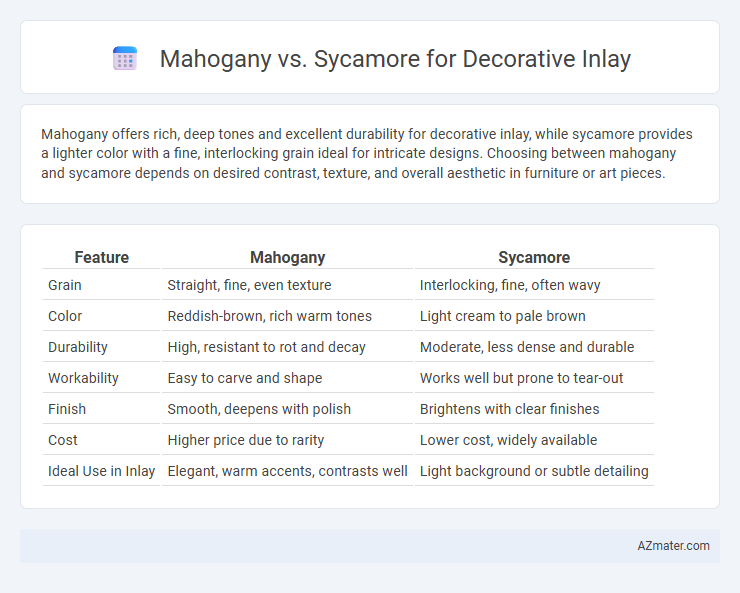Mahogany offers rich, deep tones and excellent durability for decorative inlay, while sycamore provides a lighter color with a fine, interlocking grain ideal for intricate designs. Choosing between mahogany and sycamore depends on desired contrast, texture, and overall aesthetic in furniture or art pieces.
Table of Comparison
| Feature | Mahogany | Sycamore |
|---|---|---|
| Grain | Straight, fine, even texture | Interlocking, fine, often wavy |
| Color | Reddish-brown, rich warm tones | Light cream to pale brown |
| Durability | High, resistant to rot and decay | Moderate, less dense and durable |
| Workability | Easy to carve and shape | Works well but prone to tear-out |
| Finish | Smooth, deepens with polish | Brightens with clear finishes |
| Cost | Higher price due to rarity | Lower cost, widely available |
| Ideal Use in Inlay | Elegant, warm accents, contrasts well | Light background or subtle detailing |
Introduction to Decorative Inlay Woods
Mahogany and sycamore are popular choices for decorative inlay due to their distinct grain patterns and color contrasts. Mahogany offers rich, reddish-brown tones with a fine, straight grain ideal for creating warm, elegant inlays. Sycamore provides a pale, creamy appearance with subtle figuring that enhances intricate designs and adds visual interest to woodwork.
Mahogany: Characteristics and Appeal
Mahogany features a rich, reddish-brown hue with a smooth, fine grain that enhances its appeal for decorative inlay, providing a warm and luxurious finish. Its durability and resistance to decay make it ideal for intricate designs that require both beauty and longevity. The wood's workability allows for precise carving and a polished surface, making mahogany a preferred choice over sycamore for high-end inlay projects.
Sycamore: Features and Aesthetics
Sycamore wood is prized for its fine, even texture and distinctive, swirling grain patterns, making it an excellent choice for decorative inlay. Its pale, creamy coloration with subtle variations enhances intricate designs and provides a striking contrast when paired with darker woods like mahogany. Sycamore's stability and smooth finish allow for precise carving and detailing, ensuring long-lasting beauty in fine woodworking projects.
Grain Patterns: Mahogany vs Sycamore
Mahogany features a consistent, straight grain with a fine, even texture that enhances its elegant, reddish-brown appearance, making it ideal for detailed decorative inlay work. Sycamore displays a more varied grain pattern with a wavy, curly figure and lighter, creamy tones that provide striking visual contrasts in inlay designs. The choice between mahogany and sycamore for decorative inlay often hinges on whether a smooth, uniform grain or a dynamic, textured grain is preferred to complement the overall aesthetic.
Color Variations and Visual Impact
Mahogany offers rich, deep reddish-brown hues with consistent grain patterns that create a warm, luxurious visual impact ideal for decorative inlay. Sycamore provides lighter, cream to pale brown tones with subtle, intricate grain variations that add brightness and a unique texture contrast. Combining these woods in inlay enhances color diversity and depth, producing striking, visually dynamic designs.
Workability for Intricate Inlay
Mahogany offers exceptional workability for intricate decorative inlays due to its fine, even grain and consistent texture, which allows precise cutting and smooth fitting of detailed patterns. Sycamore, while also workable, has a slightly coarser grain and can be more prone to chipping or splintering during delicate inlay processes, making it less ideal for highly detailed designs. The durability and dimensional stability of mahogany further contribute to its preference for intricate inlays in fine woodworking projects.
Durability and Longevity Comparison
Mahogany offers superior durability for decorative inlays due to its dense, fine-grained structure, which resists wear, dents, and moisture damage over time. Sycamore, while aesthetically appealing with its light, consistent grain, is softer and more prone to scratches and dents, reducing its longevity in high-traffic or frequently handled pieces. For long-lasting decorative inlay projects, mahogany provides enhanced structural integrity and retains its finish better under regular use.
Cost Considerations: Mahogany vs Sycamore
Mahogany typically commands a higher price than sycamore due to its rich color, durability, and demand in fine woodworking, impacting overall costs for decorative inlays. Sycamore offers a more budget-friendly alternative with its lighter tone and unique grain patterns, making it suitable for projects with cost constraints. Choosing between mahogany and sycamore depends on balancing aesthetic goals with budget, as mahogany increases material expenses while sycamore provides an economical decorative option.
Popular Applications in Decorative Inlay
Mahogany's rich, reddish-brown hue and fine, straight grain make it a popular choice for decorative inlay in high-end furniture, musical instruments, and luxury cabinetry. Sycamore, with its lighter color and distinctive birdseye or wavy grain patterns, is favored for creating striking contrast in decorative inlays on tabletops, architectural millwork, and custom wood panels. Both woods are valued for their workability and aesthetic appeal, enabling intricate designs and durable finishes in fine artisan crafts.
Choosing Between Mahogany and Sycamore
Choosing between mahogany and sycamore for decorative inlay depends on their distinct characteristics: mahogany offers rich, deep reddish-brown hues with a fine, straight grain ideal for producing elegant, warm-toned designs. Sycamore provides a lighter, creamy color with subtle grain patterns that enhance intricate inlay work, giving a more delicate and contemporary appearance. Consider durability, color contrast, and design style when selecting wood, as mahogany excels in classic, bold inlays while sycamore suits lighter, more subtle decorative accents.

Infographic: Mahogany vs Sycamore for Decorative Inlay
 azmater.com
azmater.com